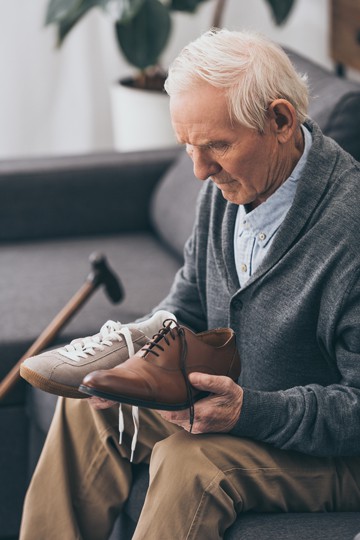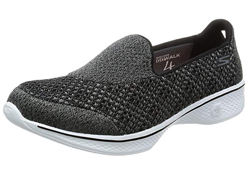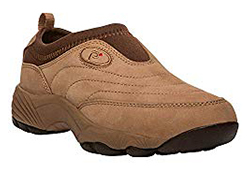By Crystal Lee | Published December 19, 2018 | Last updated June 12, 2020
Here’s a fact that might surprise you: So-called “old people” shoes don’t have to be boxy and dull. In fact, many manufacturers are catering to both the fashion and functional needs of seniors by creating footwear that provides necessary support and demonstrates a sense of style. A multitude of options are out there. The challenge lies in finding the right pair for your particular feet.
Did you know that, according to an article in Geriatric Orthopaedic Surgery & Rehabilitation, close to 80 percent of elderly people experience foot problems? Ill-fitting footwear is a major cause of those problems. So if you have any foot pain or concerns, talk to your healthcare professional. He or she may recommend that you consult a podiatrist, who can assess your condition. A podiatrist can also measure the angle of your ankles and feet in order to have molds made and custom orthotic inserts manufactured.
The information below will help you understand the common problems that seniors experience with their footwear. You’ll learn what features to look for in a pair of shoes and get practical tips that can make your shopping easier. You’ll also read about 18 different shoes that are good for older adults with various needs or health conditions.
Contents
- Common footwear problems in older adults
- What to look for in comfortable shoes for the elderly
- Tips for buying shoes
- 7 good shoes for seniors
- 5 shoes for older adults with diabetes
- 6 shoes for seniors with arthritis
Common Footwear Problems in Older Adults
As people get older, their feet undergo numerous changes that can affect the fit of their shoes. For example, your skin gets thinner and you lose fat padding on the bottom of your feet, so you may need extra cushioning in your shoes in order to stay comfortable. Your joints also get stiffer, and your arches get flatter. Plus, your feet tend to spread out more as tendons and ligaments lose strength, so you may find that you need a bigger or wider shoe than you used to.
In addition, conditions like arthritis and diabetes can cause your feet or ankles to swell, so you will likely need shoes that have adjustable openings and fasteners that can accommodate your changing size. Arthritis can also make it painful to tie up laces, so Velcro shoes for seniors may be a good option.
Here are some common foot issues that seniors experience:
- Corns or callouses—Hardened patches of skin that often develop as a result of repeated friction or pressure
- Bunions—Bony bumps that develop on the joint at the base of the big toe, forcing the joint to stick outwards
- Fallen arches—A condition in which the tendon supporting the foot arch weakens and allows the entire foot to contact the ground (something that can lead to knee and back pain)
- Hammertoe—A deformity of the toe joint that causes the toe to curl downwards rather than point forward
- Plantar fasciitis—Inflammation of a band of tissue along the bottom of the foot that causes heel pain, particularly first thing in the morning
The good news is that the pain and discomfort that accompanies these problems can often be improved by choosing the appropriate footwear. The right pair of shoes can also help keep you balanced, reduce the risk of falls, prevent knee and back problems, and encourage you to stay physically active.
What to Look For in Comfortable Shoes for the Elderly
Shoes that properly support your feet allow the muscles of your feet to work less and can result in fewer injuries. Here are a few features you may want to look for in seniors’ footwear or “elderly” shoes (i.e., shoes for older adults):

- A non-slip sole—This is essential to ensure stability and prevent falls. However, people with conditions like Parkinson’s may want to look for smooth soles that will accommodate a shuffling gait.
- Lace-free closures, such as Velcro straps—Flip-flops and other types of shoes that don’t anchor to your feet could easily slip off or cause you to trip. Many seniors want their shoes to stay firmly on their feet without having to bend down and fiddle with laces. Velcro shoes for elderly ladies and men are easier to fasten and come in various styles.
- A wide mouth—A wider opening makes it easier to get your foot in and out of the shoe, especially if your feet tend to swell. If you wear compression socks, make sure the shoe has enough space to fit them.
- Adequate padding—Cushioning absorbs and disperses the shock of your foot impacting the ground, thus reducing the effect of the impact on your hips and back. If you tend to bump your feet against objects, you may want a shoe with more padding in the upper (the part that encloses your foot).
- The right material—Shoes with uppers made of sturdy materials offer more support and insulation. On the other hand, a softer upper made of mesh will be more lightweight and provide more breathability. Some shoes feature a breathable mesh upper combined with a supportive overlay, which allows the shoe to bend with your foot without causing you to lose control.
- Removable insoles—If you plan to use either over-the-counter or custom orthotics for shoes, you may need to be able to take the insole out.
- A high back—This can help stabilize your ankle. A hard insert in the heel gives the shoe a firm structure and can help keep you from falling. However, it can also scratch or irritate your Achilles tendon if it doesn’t have enough padding.
- A low heel—Heels that are higher than about an inch and a half place undue strain on your toes and the balls of your feet by shifting your weight forward. But a shoe that is totally flat can also be uncomfortable. Look for a wide, slightly raised heel that can help take the strain off your feet and legs.
- Adequate traction—Good grip is critical, especially in shoes for elderly people with balance problems. Look for groove patterns on the bottom of the shoe that extend right to the edge. These grooves allow water to escape and help keep you steady in wet conditions.
Tips for Buying Shoes
You don’t want to waste your money on poorly fitting shoes. To help ensure that you get what you need, try following these tips:
1. Think about the purpose of your shoes.
Are you looking for comfy footwear for around the house, or are you searching for good supportive walking shoes? Do you need shoes to keep you warm and dry in a cold climate, or are you hoping for light, airy summer slippers? Determining how you plan to use your shoes will help you decide what to buy.
2. Research online, but buy in store.
It’s a good idea to look into your options and know what’s out there, but then go to an actual store and physically try on the shoes. If that isn’t possible, read online reviews carefully and consider each vendor’s return policies. Buying online is less risky if you’re getting a new pair of the same shoes you currently wear. (But keep in mind that your feet may have changed since the last time you bought shoes.)
3. Shop later in the afternoon.
Your feet expand over the course of the day, so you’ll get a more accurate fit if you try on new footwear later in the day rather than first thing in the morning.
4. Try them on and walk around.
Don’t judge a pair solely by how they feel when you’re sitting down. You need to see how they support your feet and ankles when you move about. If possible, walk on both hard and carpeted surfaces to see how the shoe performs.
5. Check the fit.
Your shoes should be sturdy enough to keep you stable without wobbling. Also, the toe box should be deep and roomy enough for you to wiggle your toes without feeling pressure. (However, the shoes should not be so roomy that your feet slide around inside.) There should be about half an inch of space between your longest toe and the front of the shoe. Remember that shoes generally won’t stretch out, so if they feel overly tight, they are probably not a good choice.
6. Don’t rush.
Try on several different pairs if possible. And make sure you put both the left and right shoes on and walk around a bit to see how they feel. You may want to ask a salesperson to measure both of your feet, as they may be different sizes. If that’s the case, go with the bigger size.
7. Don’t go too cheap.
If you can possibly afford it, spending a bit more to get the right fit is absolutely worth it.
This article contains affiliate links. We are compensated with a small commission, at no extra cost to you, for sales made through the links.
7 Good Shoes for Seniors
The most comfortable shoes for elderly men and women are those that conform to their foot shape and offer the specific protections they need. Everyone has different requirements and preferences, but here are a few shoes you may want to try:
1. Skechers Performance Women’s Go Walk 4 Kindle

These extremely lightweight shoes have a non-slip rubber sole as well as a breathable, padded mesh upper. They offer good cushioning and are almost entirely seamless, so you have little chance of developing blisters. The insole also features antibacterial odor control. Plus, the Go Walk 4 Kindle is available in more than a dozen colors, so you should be able to match it to any outfit.
2. Propet Women’s W3851 Wash & Wear Slip-On

The stretchy nylon collar of these shoes makes putting them on (and keeping them on) a breeze. In fact, these are some of the…
This article was sourced from Great Senior Living.
